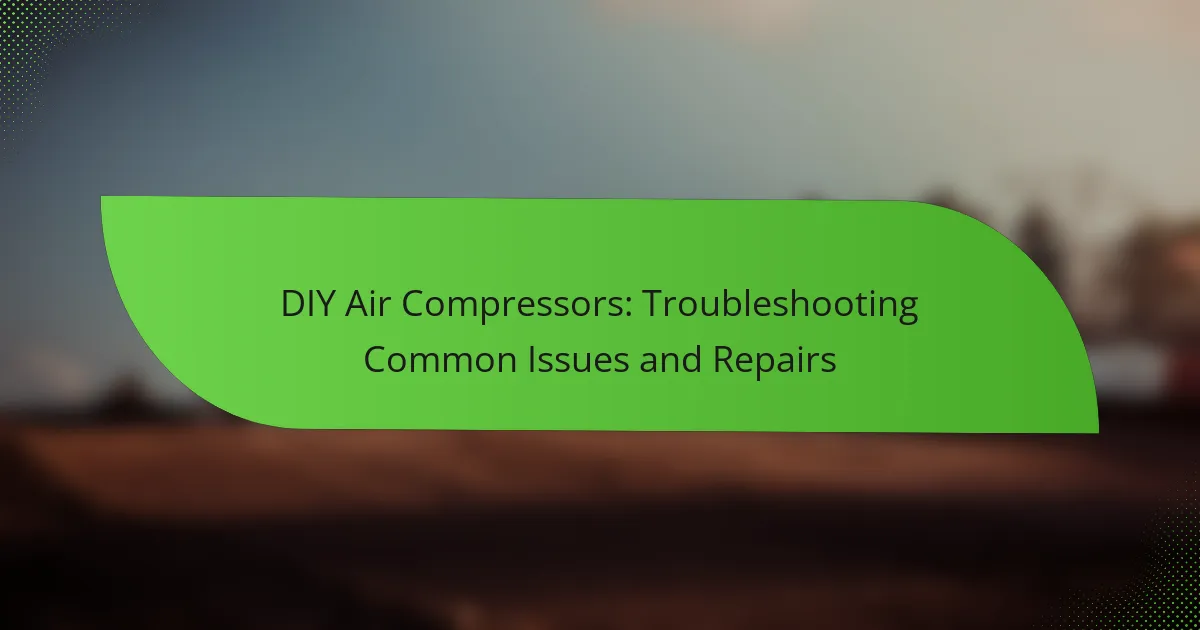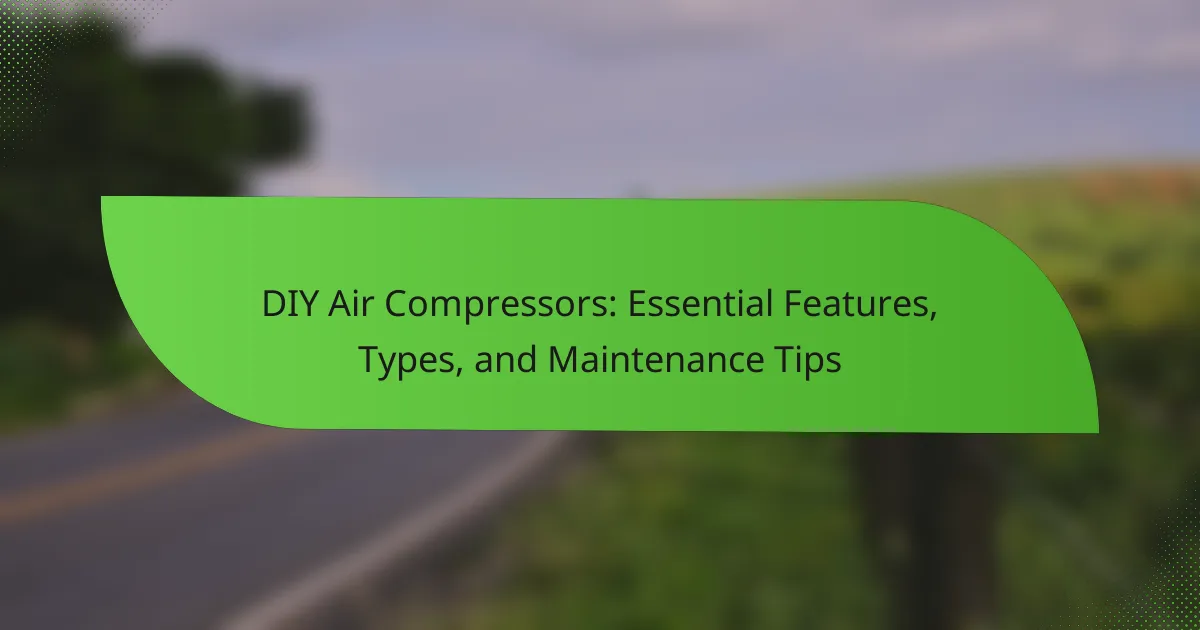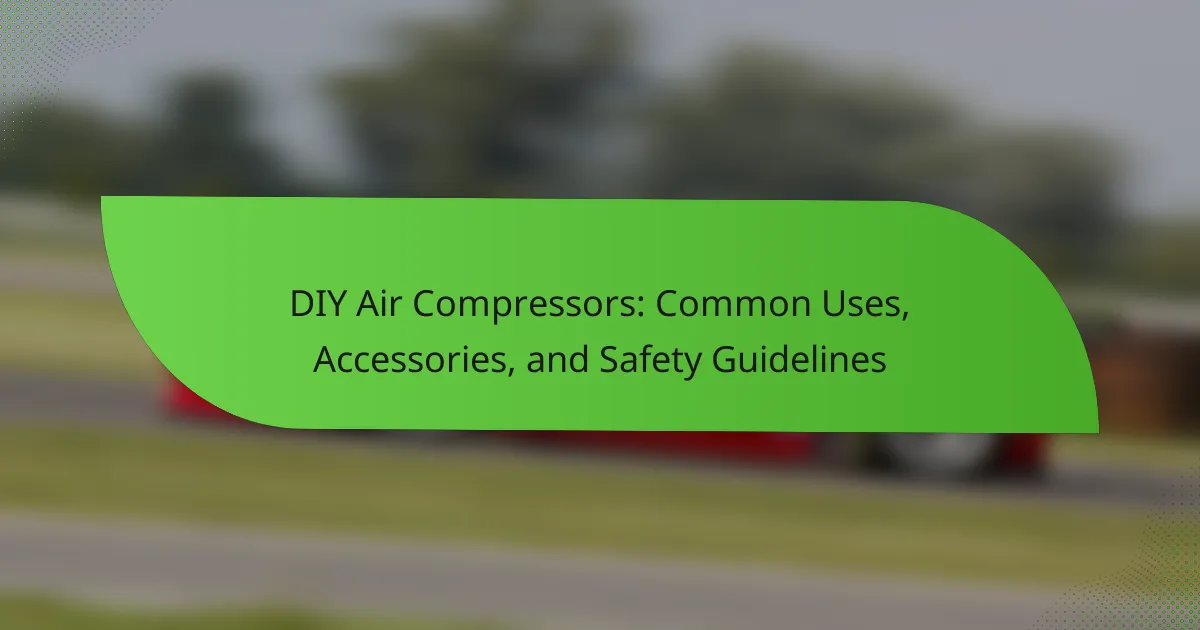DIY air compressors are devices designed to compress air for a variety of applications, including tire inflation, powering pneumatic tools, and paint spraying. This article provides a comprehensive overview of how to select the appropriate size, power, and noise level for a DIY air compressor. Key factors include determining the necessary horsepower (HP) based on intended tasks, understanding the cubic feet per minute (CFM) rating for air delivery, and assessing voltage requirements for efficiency. Additionally, the article addresses noise levels produced by different compressor sizes and offers tips for minimizing sound output through design features.
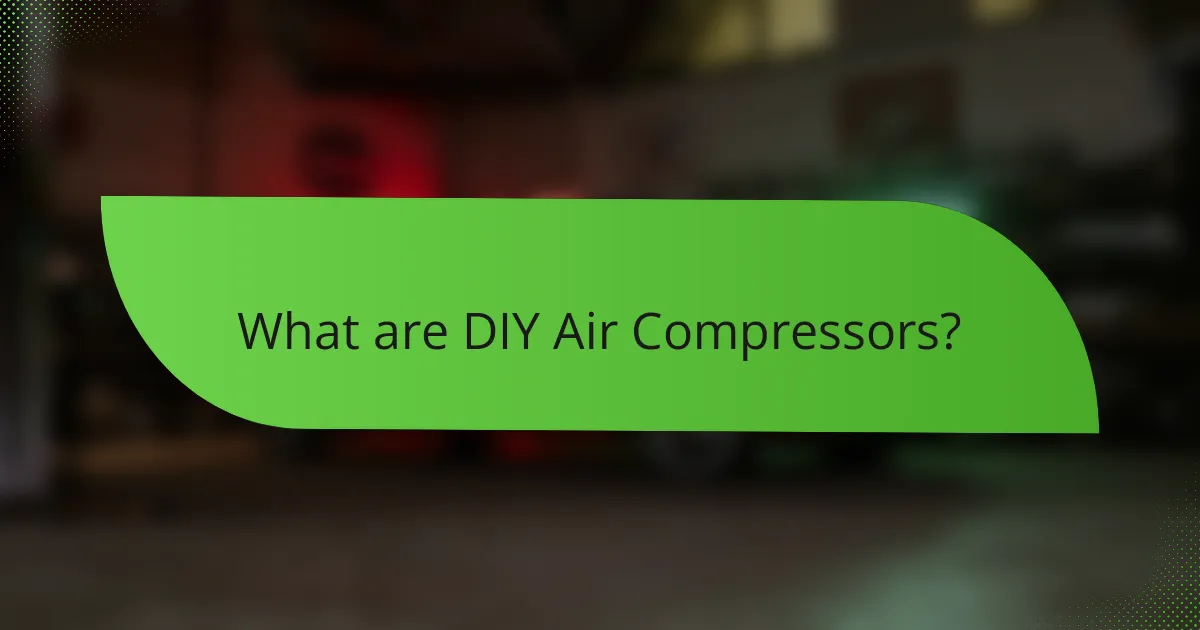
What are DIY Air Compressors?
DIY air compressors are devices that compress air for various applications. They are typically built using accessible components and materials. Common uses include inflating tires, powering pneumatic tools, and spraying paint. DIY air compressors can vary in size and power, allowing customization for specific needs. Many enthusiasts create these compressors to save costs or gain practical skills. The efficiency of a DIY air compressor depends on the design and components used. Users can find numerous guides and resources for building effective DIY air compressors.
How do DIY Air Compressors function?
DIY air compressors function by converting power into potential energy stored in pressurized air. They typically use an electric motor or gasoline engine to drive a piston. The piston compresses air in a cylinder, increasing its pressure. This pressurized air is then stored in a tank for later use. When needed, the air is released through a regulator. This process allows for various applications, such as powering tools or inflating tires. The efficiency of a DIY air compressor depends on its design and the power source used. Proper assembly and maintenance are crucial for optimal performance.
What are the key components of a DIY Air Compressor?
The key components of a DIY air compressor include a motor, a pump, a tank, and a pressure switch. The motor powers the pump, which compresses the air. The tank stores the compressed air for later use. A pressure switch controls the pressure level, turning the motor on and off. Additionally, air filters and regulators may be included for air quality and pressure control. Each component plays a crucial role in the functionality of the air compressor system.
How do these components interact to create compressed air?
Compressed air is created when components like a compressor, motor, and storage tank work together. The motor powers the compressor, which draws in ambient air. This air is then compressed within the compressor’s cylinder. As the air is compressed, its pressure increases significantly. The compressed air is stored in the storage tank for later use. The interaction between these components ensures a continuous supply of high-pressure air. This process is fundamental in various applications, including powering tools and inflating tires.
What are the different types of DIY Air Compressors?
The different types of DIY air compressors include piston compressors, diaphragm compressors, and rotary screw compressors. Piston compressors are common for home use and feature a reciprocating mechanism. They are suitable for various tasks like inflating tires and powering pneumatic tools. Diaphragm compressors are quieter and often used in applications requiring low air pressure. They work by using a flexible diaphragm to compress air. Rotary screw compressors are more efficient for continuous use but are less common for DIY projects. Each type has distinct applications and advantages, catering to different needs in DIY projects.
What are the advantages and disadvantages of each type?
The advantages and disadvantages of each type of air compressor vary significantly. Portable compressors are easy to transport and ideal for small tasks. However, they often lack power for heavy-duty applications. Stationary compressors provide more power and are suitable for continuous use. Their disadvantage is that they are not easily movable. Oil-lubricated compressors tend to be quieter and last longer. Yet, they require more maintenance compared to oil-free models. Oil-free compressors are low-maintenance and lightweight. Their downside is they may generate more heat and have a shorter lifespan. Each type has specific use cases, influencing the choice based on user needs.
How do different types affect performance and usage?
Different types of DIY air compressors affect performance and usage significantly. Each type, such as piston, rotary screw, and diaphragm compressors, has unique operational characteristics. Piston compressors are generally more powerful and suitable for heavy-duty tasks. They provide higher pressure levels, making them ideal for professional use. Rotary screw compressors are efficient for continuous operation and are often used in industrial settings. They offer lower noise levels and require less maintenance. Diaphragm compressors, while less powerful, are quieter and suitable for smaller projects. Their design allows for a more portable and user-friendly experience. The choice of compressor type influences the efficiency and suitability for specific tasks, impacting overall performance.
Why is size important when choosing a DIY Air Compressor?
Size is important when choosing a DIY air compressor because it directly affects the compressor’s functionality and suitability for specific tasks. A larger compressor typically has a higher tank capacity and can deliver more air pressure, making it suitable for heavy-duty applications like spray painting or powering pneumatic tools. Conversely, a smaller compressor is more portable and easier to store, which is ideal for lighter tasks or home use. The size also influences the compressor’s power output and recovery time, impacting how quickly it can refill the tank after use. For example, a compressor with a 20-gallon tank can provide a continuous air supply for longer periods compared to a 6-gallon model. Therefore, selecting the right size ensures that the compressor meets the demands of the intended projects while maintaining efficiency and convenience.
What factors influence the size selection for specific tasks?
The factors that influence size selection for specific tasks include the required air pressure and volume, the type of tools being used, and the duration of use. Higher air pressure and volume needs generally necessitate larger compressors. Specific tools, such as nail guns or paint sprayers, may also dictate size due to their air consumption rates. Additionally, tasks that require prolonged use may benefit from larger tanks to reduce downtime. The workspace size and portability requirements can further affect the choice. Understanding these factors ensures optimal performance and efficiency in DIY projects.
How does size impact portability and storage?
Size directly affects the portability and storage of DIY air compressors. Smaller compressors are easier to transport and store due to their compact design. They can fit into tight spaces and be carried by one person. Larger compressors, however, may require additional effort to move and need more storage space. The weight and dimensions of a compressor determine how easily it can be relocated. For instance, a 20-gallon compressor is generally bulkier than a 6-gallon model. This bulkiness can limit its use in smaller workshops or for mobile applications. In summary, size significantly influences both the ease of transport and the amount of storage required for air compressors.
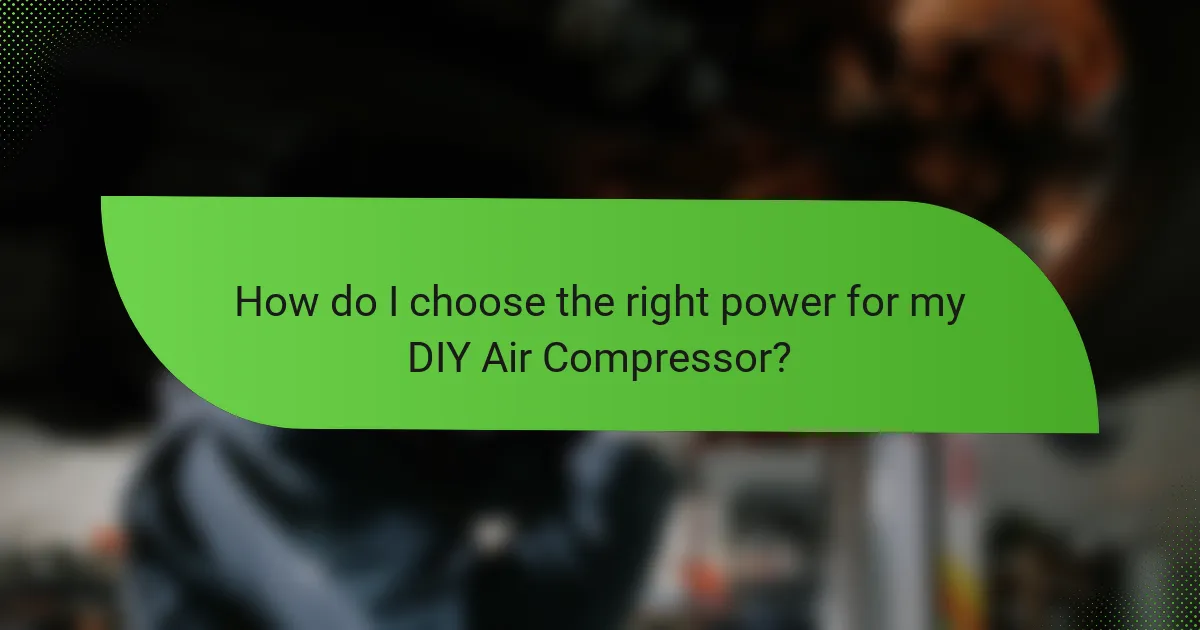
How do I choose the right power for my DIY Air Compressor?
To choose the right power for your DIY air compressor, determine the required horsepower (HP) for your intended tasks. Most DIY applications need between 1 to 5 HP, depending on the tools used. For general tasks like inflating tires, a 1 to 2 HP compressor suffices. If you plan to run air tools, aim for at least 3 HP.
Consider the compressor’s CFM (cubic feet per minute) rating as well. This rating indicates how much air the compressor can deliver. A higher CFM is necessary for tools like sanders or nail guns.
Additionally, assess the voltage requirements. Most compressors operate on either 120V or 240V. Higher voltage models often provide more power and efficiency.
Lastly, check the duty cycle, which indicates how long the compressor can run before needing a cooldown. A 50% duty cycle means it can run for 30 minutes and then needs a 30-minute break.
Choosing the right power ensures your air compressor meets your needs effectively.
What power ratings should I consider?
When choosing an air compressor, consider its horsepower (HP) and cubic feet per minute (CFM) ratings. HP indicates the motor’s power, influencing performance and efficiency. A higher HP generally means more power for heavy-duty tasks. CFM measures the air output, crucial for tool compatibility. Tools like nailers require lower CFM, while sanders need higher CFM for optimal performance. For example, a compressor with 2 HP and 4 CFM can efficiently run a brad nailer. Selecting a compressor with appropriate HP and CFM ratings ensures effective operation for your specific needs.
How does power affect the performance of the compressor?
Power directly influences the performance of a compressor. Higher power ratings typically result in increased air delivery and pressure capabilities. This means a more powerful compressor can fill air tanks faster. It also allows for the operation of more demanding tools. Compressors with insufficient power may struggle to maintain pressure. This can lead to inefficiencies and reduced performance. For example, a compressor rated at 5 HP can deliver more air than one rated at 2 HP. Therefore, selecting the right power rating is crucial for optimal performance in various applications.
What are the implications of underpowered vs. overpowered compressors?
Underpowered compressors may struggle to meet the required air pressure and flow for tasks. This can lead to inefficiency and longer work times. Overpowered compressors can provide excessive pressure, potentially damaging tools and causing safety hazards. They may also lead to increased energy consumption and higher operational costs. Proper sizing is crucial for optimal performance and safety in DIY projects.
What is the significance of duty cycle in power selection?
The duty cycle is significant in power selection for air compressors as it determines the ratio of operational time to rest time. A higher duty cycle indicates that the compressor can run continuously without overheating. Typically, a duty cycle of 50% means the compressor operates for 5 minutes and rests for 5 minutes. Selecting a compressor with an appropriate duty cycle ensures it meets the demands of the task without risk of failure. For example, a compressor with a 100% duty cycle is suitable for heavy-duty applications. In contrast, a lower duty cycle may suffice for intermittent tasks. Understanding duty cycles helps users choose compressors that match their workload requirements effectively.
How does duty cycle impact the compressor’s longevity?
The duty cycle directly impacts a compressor’s longevity by determining how long it can operate before requiring a rest period. A higher duty cycle means the compressor runs more frequently, which can lead to increased wear and tear. For example, a compressor with a 50% duty cycle can run for 30 minutes and must rest for the next 30 minutes. This resting period allows components to cool down, reducing thermal stress. Conversely, a compressor with a 100% duty cycle runs continuously, which can lead to overheating and premature failure. Manufacturers often specify the duty cycle in their product specifications, emphasizing its importance in maintenance and longevity. Regularly operating a compressor beyond its rated duty cycle can void warranties and lead to costly repairs.
What should I know about continuous vs. intermittent use?
Continuous use refers to operating a device without interruption for an extended period. This is often necessary for tasks requiring sustained air pressure. Intermittent use involves using the device in short bursts or cycles. This method is suitable for tasks that do not require constant airflow. Continuous use may lead to overheating if the compressor is not designed for it. In contrast, intermittent use allows the compressor to cool down between cycles. Selecting the right type depends on the specific application and compressor capabilities. For example, a continuous-duty compressor is designed for long-term operation, while a portable unit may be ideal for intermittent tasks.
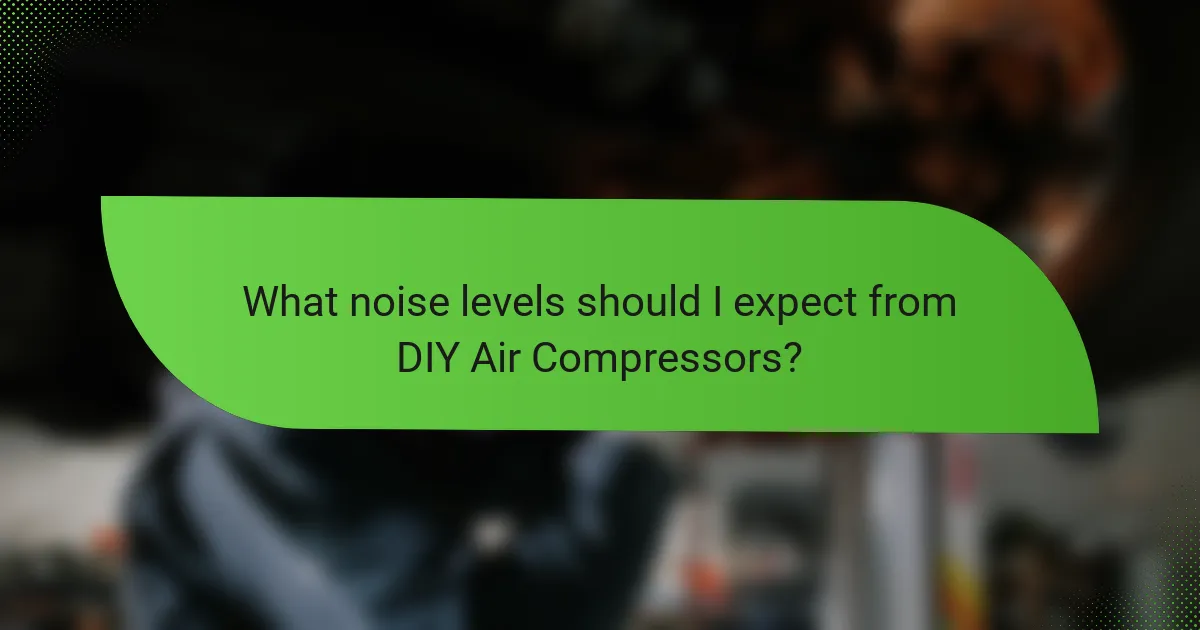
What noise levels should I expect from DIY Air Compressors?
DIY air compressors typically produce noise levels ranging from 60 to 90 decibels. The noise level depends on the compressor’s size and design. Smaller, portable compressors tend to be quieter, often around 60-70 decibels. Larger, more powerful models can reach noise levels of 80-90 decibels. For context, 60 decibels is comparable to normal conversation, while 90 decibels is similar to a lawnmower. It is essential to consider these levels when selecting a DIY air compressor for home use. Noise-reducing features, such as enclosed designs or sound-dampening materials, can help lower the overall noise output.
Why is noise level an important consideration?
Noise level is an important consideration because it impacts user comfort and health. High noise levels can lead to hearing loss and increased stress. For instance, prolonged exposure to noise above 85 decibels can cause permanent hearing damage. Additionally, excessive noise can disrupt communication and concentration. In residential areas, high noise levels may violate local regulations or disturb neighbors. Therefore, selecting an air compressor with a lower noise level enhances the overall user experience. Many models now offer sound ratings, allowing consumers to choose quieter options.
How do different compressor designs affect noise output?
Different compressor designs significantly affect noise output. Reciprocating compressors typically produce higher noise levels due to their mechanical movement. These compressors often exceed 90 dB, making them unsuitable for noise-sensitive environments. In contrast, rotary screw compressors operate more quietly, generally under 80 dB. Their continuous operation and fewer moving parts contribute to reduced noise. Additionally, scroll compressors are known for their low noise levels, often below 70 dB. The design elements, such as insulation and vibration dampening, further influence noise output. Research indicates that proper design can reduce noise by up to 20 dB in some models. Thus, selecting a compressor design is crucial for managing noise levels effectively.
What are the common noise levels associated with various types?
Common noise levels for air compressors vary by type. Portable air compressors typically operate at 60-75 decibels (dB). Stationary air compressors can range from 70-90 dB. Oil-free compressors often produce lower noise levels, around 60-70 dB. In contrast, oil-lubricated models may reach 80 dB or higher. These levels can affect user comfort and hearing safety. The U.S. Environmental Protection Agency (EPA) states that noise levels above 85 dB can lead to hearing damage with prolonged exposure.
How can I reduce noise when using a DIY Air Compressor?
To reduce noise when using a DIY air compressor, you can implement several effective strategies. First, use sound-dampening materials around the compressor. Acoustic foam or soundproof blankets can absorb sound waves. Second, place the compressor on a rubber mat. This minimizes vibrations that contribute to noise. Third, enclose the compressor in a soundproof box. Ensure proper ventilation to prevent overheating. Additionally, maintain the compressor regularly. Lubricated parts operate more quietly. Finally, consider purchasing a quieter model if noise remains an issue. Research indicates that soundproofing can reduce noise levels by up to 50%.
What are effective soundproofing methods for compressors?
Effective soundproofing methods for compressors include using acoustic enclosures, soundproof blankets, and vibration isolation pads. Acoustic enclosures are designed to contain noise while allowing airflow. Soundproof blankets can be draped over compressors to absorb sound waves. Vibration isolation pads reduce noise caused by vibrations transferring to the floor. Additionally, placing the compressor on a solid surface can minimize sound transmission. These methods can significantly lower noise levels, making compressors quieter in operation. Studies show that proper soundproofing can reduce noise by up to 50%.
How do I choose a quieter model for residential use?
To choose a quieter model for residential use, focus on the decibel (dB) rating. Models with a dB rating below 70 are generally quieter. Look for compressors labeled as “quiet” or “low noise.” These models often use oil-lubricated pumps that operate more silently. Additionally, check for features like sound enclosures that further reduce noise. Reading customer reviews can provide insights into actual noise levels during operation. Brands that specialize in quiet compressors often provide detailed specifications and comparisons.
What are the best practices for selecting a DIY Air Compressor?
Select a DIY air compressor based on your specific needs. Consider the required PSI and CFM for your projects. Match the compressor’s power to the tools you will use. Look for a tank size that supports your usage duration. Check the noise level if working in residential areas. Evaluate portability if you need to move the unit frequently. Research brands for reliability and customer reviews. Ensure you understand maintenance requirements to prolong the compressor’s lifespan.
How can I ensure I meet my specific project needs?
To ensure you meet your specific project needs, start by clearly defining your requirements. Identify the tasks you need the air compressor to perform. This includes understanding the tools or equipment you will use with it. Next, evaluate the size, power, and noise level that align with those tasks. For example, a nail gun may require a smaller compressor, while spray painting may need a larger, more powerful unit. Research the specifications of potential compressors. Compare their attributes against your defined needs. Reading reviews and ratings can provide insights into performance and reliability. Finally, consult with experts or forums for additional guidance tailored to your project.
What common pitfalls should I avoid when choosing a compressor?
Common pitfalls to avoid when choosing a compressor include selecting the wrong size, underestimating power requirements, and ignoring noise levels. Choosing a compressor that is too small can lead to inadequate performance. A compressor must meet the specific airflow needs of your tools. Oversizing can also be problematic, resulting in higher energy costs. Additionally, power requirements should match the tools being used. Not considering the noise level can lead to an uncomfortable work environment. It’s essential to check the decibel rating of the compressor. Lastly, neglecting maintenance needs can shorten the compressor’s lifespan. Regular maintenance is crucial for optimal performance.
DIY air compressors are versatile devices used for compressing air for various applications, including inflating tires and powering tools. This article provides a comprehensive overview of DIY air compressors, covering their functionality, key components, and different types, along with their advantages and disadvantages. It highlights the importance of selecting the right size, power, and noise level based on specific project needs, while also discussing factors that influence these choices. Additionally, best practices for selecting and maintaining a DIY air compressor are outlined to ensure optimal performance.
